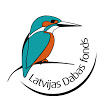April 2017
Ridala children’s trail camera: Boar herd and big antlers
The little buck – he is not really so ”little” any more, already a grown-up buck - shows himself off in all his splendour, both in daylight and in the dark of the night. With the warming of the weather the animals come less often for ”selfie photos”. Today, on March 27th, the weather is already so fine that bees attempt to collect pollen from elders and hazels and make big flights. For the first time this spring.
Buzzard nest waits for inhabitants
Image captured from last year’s webcam by Felis silvestris, LK forum
Translation Liis
Last year Mihkel visited the nest on March 13 for the first time
Buzzard Hiireviu Buteo buteo
Nest life is not always seen in the installed webcam, and this would not be the first time that it happens.
Eagle owls in Latvia
The breeding territory of eagle owls in Kurzeme (Courland) in Latvia is known since 1998. For several years nesting on the ground failed, and so a nest platform was built in a spruce at a height of 10 m in 2013. Since then the breeding of the eagle owl pair has been successful.
Copyright 2025 · Looduskalender
Designed by Zymphonies




